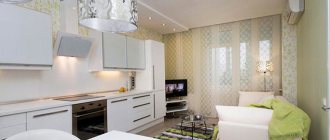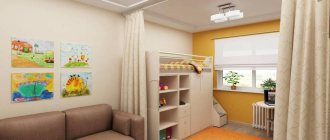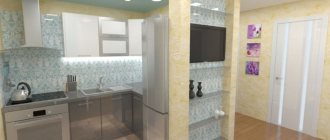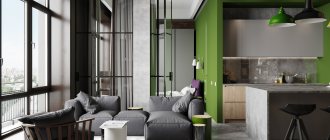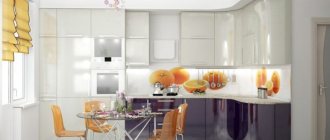In old-style apartments, a small kitchen is not uncommon. The remaining rooms in this case are often also small. Then you have to think about what to sacrifice and what space to increase. In such a situation, designers advise combining the kitchen with the living room and making a studio. This will free up space for expanding other rooms. If this option suits you, let’s start creating the design of a small living room kitchen.
A small kitchen-living room can give the room a cozy and warm atmosphere.
Design options for a small kitchen-living room (photo selection)
First, you need to open the apartment plan and figure out how best to place the kitchen elements and where the living room will be located. And only after careful planning can design options be considered.
With the help of competent actions, you can create an ergonomic and stylish space that will be distinguished by functionality.
On a note! It is advisable that natural light from the windows enter both zones.
Now you need to choose the location of the kitchen. There are the following types of kitchen layouts:
- corner;
- U-shaped;
- linear;
- parallel;
- island;
- peninsular;
- unfixed.
You should study all the zoning methods and get acquainted with beautiful design examples.
For a small room, linear and angular are best suited. When harmoniously connecting the living room with the kitchen, you can use the island and peninsula type. With its help, you will be able to correctly zone the room. Also remember to place the living room elements correctly.
Correct ergonomics is achieved by thinking through all the details and wisely using every centimeter of free space.
Choosing a layout
16 square meters is not so much, but it is enough to choose any layout option.
The linear option is considered the most economical. Here, on one side, a kitchen set is placed along the wall. And on the opposite side there is a table, chairs, a sofa, armchairs. The advantage of this option will be its versatility, the ability to make an island or peninsula. The disadvantage is the inconvenience during cooking due to the fact that you have to move a lot between the stove and the table.
U-shaped kitchen living room layout Source bezkovrov.com/
An L-shaped layout will help save space and provide more space to create a relaxation area, creating the so-called “work triangle”. There are no downsides to this type of furniture arrangement.
L-shaped kitchen layout Source design-homes.ru/
A parallel layout would be appropriate if the room has an elongated shape. By using both walls, you can conveniently place the stove, countertop and sink on one side and the refrigerator, buffet, etc. on the other.
The only condition for this layout option is that there can be no more than 1.5 meters of distance between the rows. If the passage is too narrow, it may be difficult to open the drawers. And if you make it too wide, it will be inconvenient to cook. The disadvantage of an L-shaped layout can be excessive cluttering of space. But in a square-shaped room, this option is not feasible at all.
Style for a small kitchen-living room
When you have chosen the placement and design of the kitchen and living areas, proceed to choosing a style. It can be single for the entire room, or it can be separate for the kitchen and living room. This technique will help well in zoning a room.
Modern renovation of an apartment or house involves various non-standard solutions.
Important! When mixing styles, choose those that are in perfect harmony with each other.
Loft
For a small living room combined with a kitchen, a loft-style interior, the photos of which are amazing in their variety, will be the best option. It is great for the kitchen space. And its diversity will only help, since our kitchen is combined with the living room.
The loft style provides an open area in which there are no partitions.
The loft is somewhat rough and rustic. It is characterized by technical-style lamps, painted plain walls or imitation brickwork, simple and rough furniture, and a minimal number of decorative elements. At the same time, the style is not devoid of comfort; it harmoniously combines a rough surface with soft pillows and other textiles. And thanks to the minimalism inherent in the loft, it will cope well with the task of keeping the space free.
With the help of artificially aged surfaces of walls and ceilings, you can emphasize the style of the room.
Minimalism
The best thing you can think of to decorate a small room is minimalism. Especially keep in mind that the kitchen and living room are frequently used and functional areas; everything here should be arranged as conveniently as possible.
Minimalism always looks advantageous in the interior.
The name of the style speaks for itself. Minimalism does not tolerate an abundance of accessories; here, decorative elements may be completely absent. This style works mainly with forms. Furniture and appliances are only the most necessary. If two chairs are enough in the kitchen, remove the third - this is how you can characterize the main tenet of minimalism.
Thanks to the play of contrasts, all zones in space can be clearly defined.
The main task of style is to make the space as comfortable, functional and free as possible. Minimalism is also an eco-trend, so we strive to find more points of contact between housing and the outside world. For this reason, minimalism welcomes:
- large windows to let in a considerable amount of natural light;
- natural materials for finishing;
- indoor plants;
- natural and light colors.
One of the most successful features of minimalism for a small space is the abundance of white and light colors.
Scandinavian style
The next style in our selection is Scandinavian. Also professing the tenets of minimalist and environmental trends. It also has a telling name: cold Scandinavian countries are associated with white snow and large open spaces. This style fully corresponds to your self-image.
The Scandinavian trend in interior design is becoming increasingly popular.
The most popular combination in this direction is blue and white. Gray, blue and brown are also used. The abundance of white, which is a must, gives a significant edge and makes this style ideal for a small space.
Naturalness, naturalness, naturalness are present in everything: lighting, design of walls and windows, materials from which furniture is made, etc.
In its basic principles, Scandinavian is very similar to minimalism; it also uses only the necessary furniture, does not have a lot of decorations, and pays a lot of attention to shapes and organization of space. However, there are more details and decorations here.
Feel free to purchase a soft floor rug, colored pillows and minimalist paintings.
Important! When decorating the kitchen-living room, remember the minimalist orientation of the Scandinavian style, and do not overdo it with decorations, but at the same time, do not forget about them.
Classic style
Classics will never be superfluous. Thanks to its restraint, classics are great for decorating a small room.
The living room should be decorated in a classic style.
Classic style is a broad and versatile concept. You can choose a classic direction, close to modernity, or the style can gravitate toward ancient classics - the choice depends on your own preferences.
The kitchen should be equipped with modern and compact built-in furniture.
Advice! For a small kitchen combined with a living room, modern classics are better suited.
Modern classic style is characterized by restraint and smooth lines, simple and rounded shapes, soft colors and without sharp transitions and combinations.
Simple tiles, wallpaper and laminate are suitable as facing materials.
Color and finish
Knowing the 4 basic rules for combining according to the color wheel will help you choose a palette.
- Monochrome - when one color and its shades are used for decoration. To prevent a monochrome interior from seeming boring, choose colors of the same spectrum for decoration - from the darkest to the lightest.
Monochrome gray interiors can often be seen in styles such as minimalism and hi-tech.
- Contrasting - combine colors that are opposite each other on the color wheel. Yellow and blue, red and green – seemingly incompatible with each other, but nevertheless look very impressive together. To make bright and contrasting colors comfortable to perceive, add light shades.
- Harmonic combination is the use of colors that are adjacent in the color wheel. For example, yellow and green, blue and purple, red and orange, etc.
- The classic triad is the principle of combining a triangle inside a circle. That is, you need to choose colors that are equidistant from each other (see example in the picture below).
When combining colors according to the principle of the classic triad, it is important to strictly adhere to the chosen color scheme so that the interior does not end up being colorful.
Which color is still better to choose? Below we have put together some recommendations to help you decide.
- The choice of color largely depends on the style. For example, Scandinavian style involves the use of predominantly white with bright color accents in the form of yellow, blue and green. High-tech and minimalism - monochrome basic colors, from black to white.
- When choosing your favorite color, consider the color combination rules given above and do not use more than 3 colors at the same time. You can only experiment with shades, their varying degrees of saturation.
- Consider the location of windows and the degree of illumination. For a room that lacks natural light, light warm shades are suitable to compensate for the lack of light. In a too sunny, brightly lit room, on the contrary, it is better to prefer cool tones.
- Dark shades are undesirable for finishing the floor, ceiling, work surface and apron. They can be if it is necessary to create a certain effect in the interior (for example, a black apron creates a kind of portal and the illusion of infinite space), but keep in mind that they are very impractical in everyday life: even the slightest dirt is visible on dark surfaces - dust, water stains .
The choice of finish can also be driven by style. We wrote about them in more detail above, but here we will outline several important points that should be taken into account before going to a construction or furniture store.
1. Avoid impractical solutions in the work area . Like, for example, a black embossed apron. This is the most contaminated part, which, therefore, will be cleaned more often than others.
2. The material for finishing the floor in the working part of the room must have water-repellent properties. Porcelain stoneware, ceramic tiles, PVC tiles or linoleum are best suited for this purpose. Waterproof laminate or parquet will significantly increase the cost of repairs.
A common question regarding the choice of finishing is whether it is possible to combine several finishing materials?
You can if you want to further zone the space. For example, tiles in the work area, and laminate in the living room. On the other hand, it is very difficult to find harmonious combinations of tiles and other non-waterproof materials. To maintain a single stylistic space without sacrificing practicality, take a closer look at PVC tiles (other names: vinyl laminate, quartz vinyl). Quartz vinyl is easy to care for, is not afraid of water and grease, is pleasant to the touch and is not inferior in appearance to other finishing options.
3. Wall finishing materials must also be moisture resistant. You should not glue paper-based textile wallpaper next to the set. Choose materials that can be washed. Some paints and thick vinyl wallpapers are washable.
It is on the walls that materials of different colors and textures are most often combined. For example, a popular solution is to decorate one of the walls with brickwork.
4. It’s easier with the ceiling: a white matte ceiling will always be appropriate. An emphasis on the ceiling can be made using color, gloss, a suspended structure or using stucco, although such solutions are unpopular due to the complexity and cost of execution.
The most common methods of finishing the ceiling are painting, suspended ceilings made from PVC film, or suspended from plasterboard.
The simplest, most cost-effective and fastest option is installing a stretch ceiling. When choosing this finishing method, you must make the lighting layout in advance and purchase lamps.
Painting the ceiling will take more time, but it allows you to decorate the surface with stucco patterns.
A suspended ceiling made of plasterboard makes it possible to create a multi-level structure for additional zoning of the combined space. Plus implement any lighting scenario. The disadvantage of this solution is the loss of several sentiments in the height of the room.
Space zoning rules: how to divide zones
There are plenty of options for separating the kitchen area from the living room. This can be done with:
- furniture;
- decorations;
- flooring;
- ceiling decoration;
- lighting;
- color range;
- podium;
- decor.
These are the most common methods. You can come up with your own options. The best options are separation using lighting and furniture. The divider can be a bar counter, a sofa or a dining table. It is inappropriate to use a closet in this case.
In the area where the living room will be located, you should place a large sofa on which household members can spend their free time while waiting for dinner to be ready.
You can arrange zones at different levels by placing one of them on the podium. Another unusual option: leave part of the wall or construct a beam in the middle of the room into which to mount an aquarium.
Decoration of walls, floor and ceiling in a small living room combined with kitchen
In the design rules, be guided primarily by the chosen style and pricing policy. Some styles, for example, do not accept artificial materials.
Also, do not forget about choosing a color palette. In this situation, the floor can be either light or dark, but the upper part of the room must be made in light colors, warm or cold.
It is recommended to choose light shades of wallpaper.
Functionality is also important. Do not forget that the kitchen is a place of increased pollution, and the surfaces here should be easy to clean.
Furniture for a small kitchen (photo selection)
When choosing furniture for a small living room kitchen, think about its design, and also look at a selection of our photos. Her choice also depends on the style of the room and personal preferences.
When arranging a combined kitchen-living room, you need to know that both zones should be harmoniously combined and act as a complement to each other.
Furniture for a small kitchen-living room must meet the following criteria.
- Multifunctionality. If there is an opportunity to combine a sofa with storage space, and put as much storage space into the kitchen tables as possible, take advantage of it.
- Matching style.
- Simplicity. Regardless of style, this item is necessary. In a small room, bulky and pretentious furniture will only clutter up the space.
It is desirable that the furniture is also light in color. However, you can also use dark colors in the kitchen, since this area gets dirty more than others.
If zoning is done in an apartment with high ceilings, you can divide the space using a multi-level floor.
Features of the combined space
Combining spaces has become fashionable since the mid-90s. This technique remains relevant to this day. Modern developers often offer an open plan, and residents of Khrushchev-era apartments knock down a wall to solve the problem of a small kitchen. But is it worth doing? Let's look at the advantages and disadvantages of such a solution.
Note! Combining a kitchen-living room through redevelopment requires legal grounds.
- Load-bearing walls must not be broken.
- You cannot combine a gasified kitchen with a living room.
- The kitchen should not be located above the living space.
These and other nuances should be taken into account before you begin the repair. But some of the problems can be solved. For example, you can refuse gas, and your apartment will be transferred to tariffs for electric stoves.
Redevelopment that is not legally approved always creates a safety risk for the residents of the entire house. And it will be difficult to sell an apartment with illegal redevelopment.
The main advantages of the merger are:
- a spacious room where you can freely place all the necessary equipment and furniture;
- large selection of design and layout options;
- the ability to keep an eye on children while cooking while they play in the living room;
- quick table setting in case of unexpected guests.
Arguments against" :
- the noise of technology will disturb those relaxing in the living room;
- an isolated kitchen retains food odors, while in a combined kitchen, on the contrary, the curtains, sofa and upholstery can smell;
- there is no possibility of privacy. And it is necessary when someone likes to stay up at work until late in the evening. In the absence of an isolated room and with conflicting schedules, it will be difficult not to interfere with each other;
- a separate room disappears. A bed in the bedroom is always convenient: you don’t need to lay out the sofa every day. Owners of studios and remodeled one-room apartments are deprived of this opportunity;
- allows you to hide clutter in your work area. After preparing dinner for a large group, cleaning and washing dishes can be postponed until later.
- a closing door is necessary to isolate the kitchen from the cat (relevant if there is a cat in the house).
The designer gives useful tips on arrangement in the following video:
Design techniques for implementing lighting for a small kitchen-living room
The role of lighting in a small room, and especially in the kitchen, is quite large. If it is possible to place a window in both zones, use it. If not, then place the kitchen so that light from the living room enters this area.
In rooms with a larger square footage, you can use additional options for zoning, adding new functional zones to the room.
When organizing lighting, remember that it can be used to zone space. For the kitchen triangle, that is, the work area, the best option would be spotlight recessed lighting. And above the dining table or bar counter you can place ceiling lamps of interesting design. Since the room is small, it is better to refuse a chandelier in the living room. Use the already known option of built-in lamps.
Place to rest
If the kitchen space has a square shape, then an L-shaped narrow corner can be installed in the free corner. You can complement the decor with a small dining table. Now manufacturers offer prefabricated structures that can be expanded in case guests arrive.
The photo shows a cozy interior of a small-sized kitchen living room with a corner sofa and a round table
A compact kitchen corner with a folding table is a very suitable option for a living room kitchen with a small area
A good solution for small living room kitchens is to install a countertop along a free wall. You can hide stools under it, and they will not block the passage. You can hang additional shelves or cabinets with glass doors above the tabletop. This is both additional storage space and a beautiful decoration for “bare” walls.
You can hang a picture or stick photo wallpaper above the table along the wall
A bar counter can replace a dining table - stylish and modern
If the layout allows, then you can install a small round table; the absence of corners will allow you to sit comfortably at it during lunch
When you plan to install a large table, even despite the meager square footage, you need to choose the most laconic kitchen set. The more it blends in with the walls, the tidier the room will look. In this case, the table can be placed in the center of the room, and a cozy dining room for the whole family is ready.
Using accents in a small kitchen room
Accents are important in any design. They are especially appropriate when organizing space in a minimalist style. Here accents will add life and prevent the design from being boring.
All components must be harmoniously combined with each other.
Accents can be of different types. Typically, the role of accent is played by bright details: decorations or full-fledged functional areas.
Important! The choice of a bright detail depends on what area or object you want to draw attention to.
Using accents you can divert attention from the shortcomings of the room. For example, use a bright kitchen set or house flowers that will hide the unevenness of the walls.
You need to decide on the style of the room, select the appropriate furniture and other interior details.
Designer tips for arranging a small kitchen-living room
Having analyzed all the above rules for arranging a small kitchen-living room, we have identified important advice from designers regarding the interior of such a room.
- Use light colors.
- “Yes” to minimalist and eco styles.
- Buy only necessary, as well as multifunctional furniture.
- More light.
- It is better to resort to zoning with the help of light - the most effective option.
The main thing is that the design does not weigh down the room and clutter the space.
Original interior of a small studio apartment
The interior can only be original if you add a little individualism to the chosen style and design. A small kitchen-living room can become a real work of art if its base is carefully worked out using our tips and interesting personal touches are added. Remember what you love, what delights you and causes strong sensations? Then try to translate this into the design of the room.
A selection of photos of original ideas will give you interesting thoughts.
Real photos of interiors
We have collected more inspiring design ideas in a separate selection of photos below.
See more arrangement ideas in the video:


